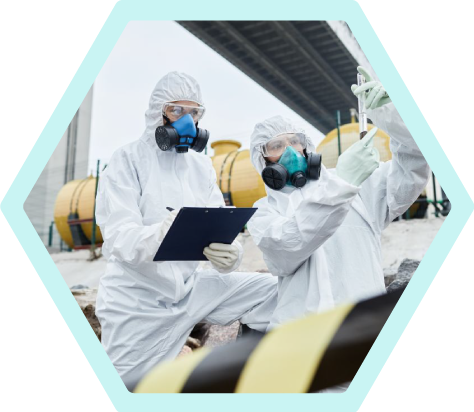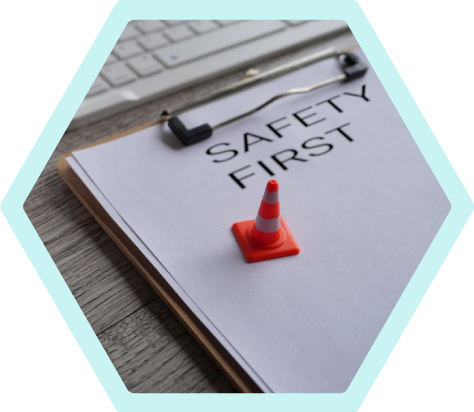In the Disaster Management Act, industrial safety activities encompass three main areas of specialization. These include supervision of hazardous industrial facilities, monitoring of hazardous goods transportation, and protection of critical infrastructure.
The regulatory, supervisory, and inspection tasks related to hazardous industrial facilities, as well as disaster management responsibilities of regional agencies, extend to various previously unregulated hazardous activities. These include, among other things, sub-threshold facilities, facilities classified for special treatment, hazardous goods transportation (by road, rail, water, and air), and tasks related to the protection of critical infrastructure.
National Disaster Management Directorate held an online professional day on December 4, 2020. A brief overview of the topics is provided below.
The amendment to the Government Decree 219/2011 (X. 20) on the prevention of serious accidents involving dangerous substances modified some aspects of planning for major accidents and the organization of exercises involving dangerous substances. It is now mandatory to annually train and document the preparedness of employees for exercises. When planning exercises, the timing must be coordinated with authorities, taking into account operational conditions related to the season and time of day. The deadlines for ensuring public access have also been revised. The presentation also included a report on previous inspection criteria and the implementation of annual inspection plan.
The authorities examined and evaluated the quality of investigations conducted by operators in the case of operational disruptions. About 50% of operator investigations were considered acceptable in terms of quality and scope. The evaluation was primarily based on whether the investigation covered both technical and organizational aspects and management system, as well as whether the investigation was sufficiently in-depth to identify and address root causes. National Disaster Management Directorate’s central website provides guidance and outlines the methodology for investigating operational disruptions involving hazardous materials based on cases that have occurred.
National Disaster Management Directorate developed a new guideline by adapting evaluation methodology of Italian INAIL (a non-profit organization dealing with work-related injuries). The essence of this methodology is to systematically analyze the multi-aspect aging phenomenon, step by step, and provide a simple, tangible analytical method for each manifestation. The next step involves assessing awareness and measures taken by the operator concerning aging, which is also structured step by step and results in an index. Comparing the two indices ultimately reveals the severity of the aging phenomenon in a given facility.
Almost all operators made significant efforts to adapt quickly to pandemic situation. The presentation included recommendations and best practices, primarily related to compliance with pandemic measures and the topic of shutdown and restart.
On December 6, 2016, Dr. Zoltán Góra, Director-General of National Disaster Management
Directorate, and Tibor Klement, President of MAVESZ, signed a cooperation agreement
between MAVESZ and National Disaster Management Directorate. The document outlines
basic principles of cooperation, emphasizing common interest in implementing EU SEVESO
III Directive for the safety of facilities handling hazardous substances. The agreement also
establishes a framework for expert consultations between the two organizations, sets up an
expert committee to assist in the preparation of regulations, and outlines the responsibilities of
the parties in operating MAVESZ Chemical Industry Alert and Information Center (VERIK).
In March 2017, MAVESZ held Chemical Logistics Conference in Budapest, where topics related to the regulation of transportation and warehousing of hazardous goods and the expected trends and regulatory challenges in hazardous goods logistics for the post-2020 period were discussed.

In everyday life, we use various words when talking about risks, and some of these can be misleading. When it comes to chemicals, risk and danger are often considered interchangeable concepts. Below, we’ll outline the difference between these two terms based on a CEFIC publication. Understanding this difference is essential for meaningful discussions about the safety of chemicals and processes.
is the way an object or situation can cause harm.
Danger exists when an object (or a substance) or a situation possesses a capability that can lead to harmful outcomes. Examples of dangers (sources of danger) can include a broken sidewalk, a machine without protective covering, an icy road, a fire, an explosion, or the sudden release of a toxic gas.


is the extent to which recipient of harm is likely to be exposed to danger.
The presence of potential recipients in a given area and their distance from the source of danger determine the level of risk. For example, a fire or an explosion can cause damage to nearby buildings and their interiors, as well as to vehicles or equipment, but it will not cause harm to people if there are no individuals nearby at that moment.
is the likelihood of harm occurring.
As mentioned earlier, danger exists when an object (or substance) or situation possesses internal characteristics that can cause harm. But risk is the possibility of this harm occurring; in other words, risk can be significant or negligible.
In our everyday lives, we are surrounded by risks. We continuously assess these risks, consciously or automatically, in one way or another. When deciding whether to cross the road, eat healthily, or take care of our families, we always evaluate the potential sources of danger and assess the risks before taking action.
And since there are risks in our daily lives, they also occur in the activities of companies and are associated with the products they produce.
BUT: For harm to occur in practice, or in other words, for there to be risk in a given situation, both danger and exposure must be present simultaneously. If either one is missing, there is no risk.
Take a dangerous animal as an example. It is a source of danger. When the animal is free, people around it are exposed to this danger. Therefore, there is a risk that this animal will attack these people. However, if the animal is in a cage, it remains just as dangerous, but no one is exposed to this danger, so there is no risk.
Risk = source of danger + exposure


“Every substance is poison, there is none which is not a poison. The right dose differentiates a poison from a remedy.”
Paracelsus (1493-1541)
Does a hazardous chemical substance pose a risk? For risk to occur, both the source of danger and exposure must be present simultaneously.
Hazard of chemical substances means that they have properties capable of causing adverse effects on people or the environment. Risk is the chance of these effects occurring. Even if a chemical substance has hazardous properties, the risk to humans or environment is extremely low if the substance is handled safely under controlled conditions.
Risk assessment is a key management tool for determining how and under what conditions harm can occur. To assess risk, both danger and exposure must be taken into account. While there are many methods for conducting risk assessments, it is crucial to choose the best approach.
The most reliable basis for conducting risk assessments is a sound scientific method. This should be the cornerstone of an effective and successful chemical policy. Every risk management decision must be based on risk assessment, taking into account current use and exposure. The internal properties of chemical substances alone should not be the sole consideration.
According to MAVESZ (Hungarian Chemical Industry Association) national regulations aimed at preventing serious industrial accidents involving hazardous substances are considerably stricter than EU regulations, going beyond the principles and rules set out in the EU SEVESO III Directive.
In Hungary, over 750 facilities fall under the scope of the regulation, which is close to the number in Spain. However, the value of production in the Hungarian chemical industry is less than a tenth of that in Spain. While the rate of inspections of upper threshold facilities in our competitors’ countries was 74% in Austria, 60% in Germany, 15% in Italy, 63% in Spain, 75% in the United Kingdom, and 84% in Belgium in 2011, the authorities in Hungary inspect upper threshold facilities at the local, county, and national levels multiple times a year, often in the same areas with only a few days or weeks apart. Such an extensive presence of industrial safety authority is not supported in any professional manner, and it unnecessarily distracts the leaders and employees of companies from their substantive work.
This overregulation places a difficult-to-justify burden not only on large companies but also on smaller chemical industry enterprises. This goes against the declared government intention to build the future economy of our country on manufacturing businesses. It is unfortunate that the preparation of the application of SEVESO III in Hungary, as presented in 2013 proposal, contains further strictures instead of addressing problems arising from requirements that outbid other EU member states without contributing significantly to improving industrial safety.
VERIK Center Contact Information
VERIK – Responsible Care – ICE
Many member companies of Hungarian Chemical Industry Association joined Responsible Care international program in 1992. This commitment by business organizations confirms their dedication to taking all measures required of them for enhancing safety, health, and environmental protection both inside and outside their factory gates.
One important manifestation of this commitment is the voluntary establishment and operation of Hungarian Chemical Industry Alert and Information Center (VERIK) system within the framework of European ICE (Intervention in Chemical Transport Emergencies) program.
Hungarian chemical industry assists in the prevention and reduction of harmful effects of accidents and extraordinary events during the transportation of hazardous materials. The voluntary operation of VERIK system complements national disaster prevention and response system and is based on existing organizations and corporate experts. It is a non-profit organization, serving as a support structure for the operation of upper threshold facilities, through the closest center to the location of an accident. The majority of these centers maintain 24-hour availability.
VERIK centers are prepared to provide assistance related to chemicals they manufacture and use. Beyond their own chemical materials, the MOL FER VERIK Center has built a wide-ranging information database.
This continuously expanding information system enables the center to effectively contribute to the prevention and reduction of harmful consequences of accidents and extraordinary events occurring during the transport of a much larger range of materials than those they produce or use.
Dr. György Sárosi: Transportation of Dangerous Goods in the Early 21st Century – ADR 2011
In his article, a recognized expert in the logistics of dangerous goods examines the theoretical and practical questions of the sixth amendment of the ADR.
As he writes, “The changes in the ADR in 2011 affect the entire ADR. The approximately 100 pages of text modifications result in various significant and minor changes in all nine parts. There are entirely new provisions that we have not encountered before, and there are also changes that further tighten or clarify the existing provisions, possibly correcting some previous errors. Unfortunately, practical experts have increasingly formulated that biennial amendments are too frequent to properly develop and implement new regulations. There are several examples of inadequately considered or developed amendments.”
The article reviews modifications, partly following the structural layout of the ADR, and partly taking into account the importance of the changes. Modifying provisions of Appendices A and B of the ADR are contained in the document UN ECE/TRANS/WP.15/204, dated March 12, 2010, along with its amendments, additions, and corrections, which were finally completed in June 2010. The new ADR is valid from January 1, 2011, but old provisions can be applied until June 30, 2011. Directive 2010/61/EU of the EU also makes the introduction of ADR 2011 mandatory for member states, at the latest from July 1, 2011. This means that, according to EU directive, Hungary must start applying ADR 2011 from July 1, 2011.
Tank Cleaning
1990-2026 MAVESZ All rights reserved | web: Hedi webdesign